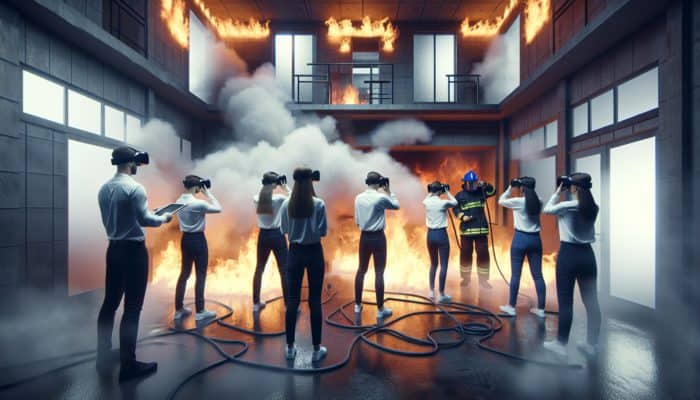Acquire Critical Fire Safety Skills to Protect Lives and Property
Deepening Your Understanding of Fire Dynamics and Behaviour for Maximum Safety

Understanding the basic principles of how fires ignite and spread is essential for developing effective fire safety skills. Every fire begins with the interaction among a fuel source, an ignition source, and oxygen, forming the well-known fire triangle. Once a fire is ignited, it can escalate rapidly, consuming oxygen and generating intense heat. By gaining insights into fire behaviour, individuals can better anticipate potential fire risks and craft efficient emergency response strategies. For instance, recognising that fires tend to spread more swiftly in windy environments can be especially beneficial for those living in coastal areas, empowering them to implement proactive measures against wildfires.
Fires can spread through processes such as conduction, convection, and radiation, highlighting the necessity of identifying fire hazards in various environments. In urban settings, where wooden structures are prevalent, the potential for fire to leap from one building to another increases significantly. A comprehensive understanding of fire behaviour is crucial for devising effective containment and extinguishment strategies applicable in residential, industrial, or wilderness scenarios. Professionals specialising in fire safety leverage this knowledge to design safer buildings and formulate extensive fire response plans. By familiarising themselves with fire behaviour, community members can transition from passive observers to proactive participants in safety measures and emergency preparedness.
Implementing Actionable Fire Prevention Techniques in Everyday Life
To significantly reduce fire hazards in both domestic and public settings, it is essential to adopt fundamental fire prevention strategies. Simple yet impactful actions can greatly mitigate risks and protect lives. Here are some crucial preventative measures everyone should integrate into their daily routines:
- Perform regular inspections and maintenance on electrical appliances to prevent malfunctions.
- Store flammable materials, such as chemicals and gasoline, in proper containers away from heat sources.
- Install smoke alarms on every level of your home, testing them monthly to ensure they function properly.
- Maintain a clear area around heat sources, ensuring they remain uncluttered.
- Adopt safe cooking practices, such as monitoring food while cooking and promptly cleaning up spills.
- Create a designated no-smoking zone, especially in homes with flammable materials.
- Ensure easy access to fire extinguishers and confirm that everyone is aware of their locations.
- Participate in community fire safety workshops and drills to remain informed and prepared.
These foundational practices are the cornerstone of effective fire prevention strategies. Communities that prioritise ongoing fire safety education and drills cultivate a culture of awareness, embedding fire safety into the core of their values. It is vital to continuously revisit and adapt these strategies to address emerging risks, ensuring that all individuals remain vigilant and proactive in their approach to fire safety.
Recognising the Significance of Fire Safety Education for Everyone
Fire safety education is a fundamental aspect of creating safer environments; it equips individuals with vital knowledge necessary for decisive action during emergencies. Without adequate education, panic can set in, leading to hasty decisions during a fire, which significantly heightens the risk of injury or loss of life.
Worldwide, communities are increasingly recognising the critical importance of fire safety education. For example, many educational institutions incorporate fire drills and lessons about fire hazards into their curricula. Organisations like the National Fire Protection Association (NFPA) provide essential resources for community fire safety programmes. Such initiatives not only teach individuals how to respond during emergencies but also foster a mindset of prevention and vigilance.
The benefits of fire safety education extend well beyond knowledge acquisition; they instil confidence in individuals, empowering them to take active roles in ensuring their safety and that of others. Consistent training can mean the difference between managing a minor incident successfully and facing a catastrophic event. Hence, continuous education is crucial for reinforcing the message that fire safety remains a priority across diverse demographics and regions, tailored to the specific cultures and environments of local communities.
Gaining Proficiency with Fire Safety Equipment for Effective Emergency Response

Being adept in the use of fire safety equipment is crucial for ensuring a quick and effective response during emergencies. Knowing how to operate fire extinguishers, smoke alarms, and other safety devices can prevent minor incidents from escalating into significant disasters. Each piece of equipment has a specific function, and comprehending these nuances can greatly enhance the safety of both yourself and those around you.
Fire extinguishers, for instance, are classified into four primary categories: Class A for ordinary combustibles, Class B for flammable liquids, Class C for electrical fires, and Class K for cooking oils and fats. Familiarity with the PASS method for using extinguishers—Pull the pin, Aim low, Squeeze the lever, and Sweep from side to side—is essential. Regular inspections of smoke alarms, along with annual battery replacements and confirmation of proper installation, can indeed save lives.
Furthermore, understanding the limitations of fire safety equipment is equally important. Not all fire extinguishers are suitable for every type of fire, and using the incorrect one could exacerbate the situation. Participating in training sessions where individuals can practise using equipment in controlled settings can significantly enhance preparedness. In public environments, ensuring that staff are well-versed in fire safety equipment is crucial, as this enables them to assist patrons effectively during emergencies.
Implementing Key Emergency Evacuation Procedures to Ensure Safety
Practising emergency evacuation procedures can significantly reduce panic and injuries during a fire. A well-structured evacuation plan should be customised to fit the specific layout of a building and the unique needs of its occupants. Conducting regular drills allows individuals to become acquainted with exits, routes, and assembly points, ensuring a swift and safe exit when every second is critical.
Creating a comprehensive evacuation plan entails mapping out multiple exit routes and ensuring they remain clear and accessible at all times. Identifying areas where individuals may become trapped, such as hallways or stairwells, is essential. These areas should be marked with signage that directs individuals toward the safest paths. Regularly practicing these procedures helps everyone become accustomed to the routine, thereby minimising confusion and anxiety during actual emergencies.
Moreover, clearly communicating emergency contacts and assembly points to all occupants is vital. In workplaces, it is essential to train staff to assist those with disabilities during evacuations, promoting inclusivity and safety for all. The psychological benefits of practising evacuation procedures are profound; familiarity breeds confidence, which can be lifesaving. When individuals know what to expect, they are more likely to remain calm and focused during emergencies, ultimately enhancing the overall safety for everyone involved.
Insights from Experts for Advancing Your Fire Safety Skills
Enhancing Fire Safety Training with Expert Guidance

Experts play a crucial role in enriching fire safety training by providing specialised knowledge and the latest insights on best practices. Their expertise enables organisations to develop comprehensive fire safety programmes that go beyond basic education. By analysing current trends and technological advancements, experts can offer tailored training that addresses specific needs and risks.
For instance, expert-led training sessions often include realistic simulations that mimic emergency situations. This immersive approach allows participants to rehearse their responses in controlled environments, reinforcing their learning while boosting their confidence. A noteworthy example is the utilisation of Virtual Reality (VR) technology in fire safety training, enabling individuals to navigate fire scenarios without real danger. This innovative training method not only makes sessions more engaging but also facilitates repeated practice in various situations.
Moreover, experts can evaluate existing fire safety protocols within organisations, identifying gaps and areas that require improvement. By conducting thorough assessments, they can recommend adjustments tailored to the facility’s layout, operational characteristics, and occupant demographics. Regularly updating training materials and methodologies based on feedback and advancements ensures that fire safety education remains relevant and impactful. Organisations that invest in expert-led training not only comply with safety regulations but also cultivate a culture of preparedness and responsiveness.
Staying Informed with Innovative Fire Safety Solutions
The domain of fire safety is continuously evolving, with innovative solutions emerging to enhance safety protocols and equipment. Staying updated on these advancements is crucial for individuals and organisations dedicated to effective safety management. One remarkable innovation is the implementation of smart fire detection systems that integrate with IoT devices, providing real-time monitoring and alerts. These systems can notify occupants and emergency services, significantly reducing response times.
Another exciting development is the introduction of fire-resistant materials used in construction. Modern materials are designed not only to resist ignition but also to minimise the spread of flames and smoke, thereby protecting both lives and property. These materials are particularly critical in urban environments, where the close proximity of structures can heighten fire risks.
Furthermore, the incorporation of drones in fire safety has transformed how emergency responders assess situations. Equipped with thermal imaging, drones can identify hotspots over large areas, allowing for more efficient resource allocation during firefighting operations. This technology provides firefighters with real-time data, enabling them to make informed decisions in high-pressure scenarios.
Training programmes are also benefiting from technological advancements, integrating virtual and augmented reality to simulate fire conditions. These immersive experiences enhance understanding and decision-making capabilities, providing individuals with a realistic sense of urgency. As fire safety technology continues to progress, organisations must proactively adopt these innovations to ensure preparedness for future challenges.
Effectively Implementing Expert-Recommended Fire Safety Plans
Establishing expert-recommended fire safety plans is essential for creating a structured and proactive approach to fire safety. These plans typically encompass detailed procedures for fire prevention, response, and recovery, ensuring that individuals and organisations are well-equipped for emergencies. The initial step in developing a fire safety plan is to conduct a comprehensive risk assessment, identifying potential hazards and evaluating existing fire safety measures.
Once risks are identified, experts can suggest strategies customised specifically for the environment. This may involve upgrading fire suppression systems, improving emergency lighting, or ensuring that evacuation routes remain clear. Regular training sessions should be organised to familiarise employees and residents with the plan, ensuring that everyone understands their role during an emergency.
Establishing clear communication protocols in the event of a fire is also imperative. This includes designating a fire warden or safety officer responsible for coordinating responses and ensuring that everyone is accounted for. Regularly reviewing and updating the plan is essential, as changes in personnel, building layout, or operations can affect fire safety dynamics.
Conducting fire drills based on the plan provides invaluable hands-on experience. These drills reinforce procedures and help identify areas needing improvement. Implementing expert-recommended fire safety plans fosters a culture of safety, empowering individuals to act decisively and confidently during emergencies.
Practical Fire Safety Skills for Everyday Situations
Mastering the Safe Operation of Fire Extinguishers for Effective Response
Knowing how to properly operate fire extinguishers is crucial for saving lives during a fire emergency. Adequate training in using extinguishers ensures individuals can respond swiftly and effectively to small, contained fires before they escalate into larger, more severe incidents. The key to using a fire extinguisher is to follow the PASS method: Pull, Aim, Squeeze, and Sweep.
Begin by pulling the pin at the top of the extinguisher to break the tamper seal. Next, aim low, directing the nozzle at the base of the fire rather than the flames themselves. Squeeze the handle to release the extinguishing agent, sweeping the nozzle from side to side to effectively cover the fire. It is crucial to maintain a safe distance from the fire, usually between 6 and 8 feet, depending on the size of the extinguisher and the intensity of the fire.
Familiarity with the various types of extinguishers is vital. For instance, Class A extinguishers are suitable for ordinary combustibles, while Class B extinguishers are tailored for flammable liquids. Using the incorrect type can exacerbate the situation. Training should encompass real-life scenarios, allowing individuals to practise with extinguishers under supervision. This hands-on experience builds confidence and ensures readiness when it matters most.
Additionally, knowing when to use an extinguisher is equally important. If the fire is too large or smoke becomes overwhelming, evacuating and contacting emergency services is the safest option. Understanding these principles enables individuals to shift from passive observers to proactive responders, thereby enhancing safety in both homes and workplaces.
Creating a Comprehensive Home Fire Escape Plan
Developing a detailed home fire escape plan is an essential safety measure that can significantly improve the likelihood of a safe evacuation during a fire. A well-structured escape route should be tailored to the unique layout of each home and practised regularly with all household members. The first step involves drawing a floor plan that indicates two exits from every room, typically a door and a window.
It is crucial to designate a meeting place outside the home. This location should be a safe distance away, allowing everyone to gather after evacuating, which makes it easier to ensure that all household members are accounted for. Regularly practising the escape plan helps familiarise everyone with the routes and ensures they can execute the plan confidently, even under stress.
When conducting practice drills, consider varying circumstances, such as simulating a fire occurring at night or blocking exits to encourage creative problem-solving. This adaptability prepares individuals for real-world scenarios, helping them think quickly during emergencies. Furthermore, ensure windows can be opened easily and that any security bars have quick-release mechanisms.
Keeping escape routes free from clutter and ensuring doors and windows are accessible is essential for a smooth evacuation process. Adequate lighting, particularly in hallways and staircases, is vital for safe movement. Regularly reviewing and updating the escape plan in response to changes in the household or home layout reinforces preparedness and enhances overall safety.
Actions to Take If You Find Yourself Trapped by Fire
Being trapped by fire is a harrowing experience, but knowing the right actions can save your life. The first step is to protect yourself from smoke inhalation, which is often more dangerous than the flames themselves. If you find yourself in a room, close the door and seal any gaps with clothing or towels to keep smoke at bay.
Stay low to the ground, where the air is clearer. If there’s a window, signal for help by waving a brightly coloured cloth or using a flashlight. If you have a mobile phone, call emergency services and provide them with your location. If smoke begins to fill the room, cover your mouth and nose with a damp cloth to filter out harmful particles.
If the fire is approaching and evacuation is impossible, consider remaining in a room with a window that opens. Keep the door closed and stay low while awaiting assistance. Your safety can be significantly improved by maintaining visibility and signalling for help. The key is to remain calm and think critically under pressure, utilising every available resource. Preparation is vital; by practising scenarios and discussing strategies, you can instil resilience and confidence in all household members.
Identifying and Mitigating Common Fire Hazards in Your Home
Recognising and addressing common fire hazards within the home is crucial for preventing fires before they occur. Every household should conduct a fire hazard assessment, focusing on areas that may pose risks. Common culprits include faulty wiring, overloaded electrical outlets, and improperly stored flammable materials.
Regularly inspecting electrical appliances and cords for signs of wear and tear is essential. Damaged wiring can spark fires, so replacing frayed cords and using appliances in accordance with the manufacturer’s instructions is crucial. Additionally, avoid using extension cords as a permanent wiring solution, as this can overload circuits and heighten fire risk.
Another significant hazard is the improper storage of flammable materials. Household items such as paints, solvents, and cleaning supplies must be stored in a cool, dry location away from heat sources. Similarly, keeping combustibles at a safe distance from stoves and heaters reduces the risk of accidental ignition.
Creating a clutter-free environment is also essential. Items piled near heat sources can easily ignite, increasing the likelihood of fires. Regularly clearing out spaces such as attics and garages ensures that potential hazards are minimised. Involving the entire household in recognising and mitigating these risks fosters a proactive safety culture, ultimately enhancing overall fire safety at home.
Fundamental First Aid Techniques for Treating Burns and Smoke Inhalation
Understanding basic first aid can significantly influence outcomes in fire-related emergencies, particularly in cases of burns and smoke inhalation. Immediate and appropriate responses can reduce the severity of injuries and even save lives. For treating burns, the first action is to cool the affected area under running water for at least 10 minutes. This helps mitigate damage and alleviate pain.
For minor burns, applying a sterile bandage or burn ointment can promote healing. It is crucial to avoid applying ice directly to the burn, as it can cause further tissue damage. In cases of severe burns or those covering a large area, seeking immediate emergency medical assistance is vital.
Smoke inhalation presents a different set of challenges. If someone has been exposed to smoke, moving them to fresh air is paramount. Encourage them to take deep breaths outside of the smoke’s reach. If they show symptoms such as coughing, difficulty breathing, or confusion, prompt medical attention is necessary.
In both scenarios, having a basic first aid kit readily available can enhance emergency preparedness. The kit should include burn dressings, antiseptic wipes, and clear instructions for use. Regularly reviewing first aid techniques and conducting training sessions within households or communities can ensure that everyone is prepared to respond effectively in emergencies.
Fire Safety Skills in Public Spaces
Identifying Fire Hazards in Public Areas to Enhance Safety
Public spaces are typically bustling environments, making them susceptible to various fire hazards that need to be identified and addressed. Regular inspections are critical for maintaining a safe environment in schools, shopping centres, offices, and parks. Key fire hazards include blocked exits, malfunctioning alarms, and improperly stored flammable materials.
Conducting routine safety audits helps organisations spot potential risks before they escalate into emergencies. For instance, ensuring that fire exits are clearly marked and accessible can save lives in an emergency situation. Additionally, performing checks on fire extinguishers and alarms guarantees they are operational and ready for use.
Training staff in fire safety awareness is essential. Employees should be well-informed about identifying hazards and understand the importance of reporting issues promptly. Engaging the community through fire safety workshops can raise awareness about common hazards and foster vigilance within the community.
Moreover, community events can serve as platforms to educate the public on fire safety measures. By hosting demonstrations, sharing resources, or offering safety assessments, communities can cultivate a culture of safety consciousness. Effective communication and collaboration among local businesses, schools, and fire departments are vital for addressing and mitigating fire hazards in public spaces.
Responding Effectively to Fire Alarms in Public Buildings
Knowing how to respond to fire alarms in public buildings can prevent panic and ensure orderly evacuations. When an alarm sounds, individuals should remain calm and follow established procedures. The first step is to stop any ongoing activities and promptly assess the situation.
In a crowded area, it is crucial to avoid pushing or shoving, as this can lead to injuries. Instead, follow the designated exit routes in an orderly manner. Familiarity with the building’s layout, including emergency exits and assembly points, enhances the efficiency of the evacuation process.
Public buildings must feature clear signage indicating evacuation routes and procedures. Regular drills should be conducted to familiarise occupants with emergency protocols, reinforcing the importance of swift and safe evacuations. Staff should be trained to assist patrons in navigating exit routes, especially those who may require additional support.
Communication is key during an evacuation. An audible alarm should be supplemented with clear announcements, guiding individuals to exit safely. After evacuating, it is essential to gather at the predetermined meeting point, ensuring everyone is accounted for before re-entering the building. An organised response to fire alarms not only saves lives but also minimises chaos during emergencies.
The Responsibilities of Public Space Managers in Ensuring Fire Safety
Managers of public spaces hold a critical responsibility in maintaining fire safety. Their role involves implementing and sustaining fire safety protocols to protect all occupants. This includes developing comprehensive fire safety plans that address risks unique to the facility and its operations.
Regular inspections are necessary to identify potential hazards, including assessing fire exits, extinguishers, and alarm systems. Managers must also ensure that staff members are adequately trained in fire safety procedures, equipping them with the knowledge to act effectively during emergencies.
Engaging with local fire departments can enhance safety measures. Collaborating with fire officials to conduct drills and assessments ensures that protocols are current and meet established standards. Public space managers should advocate for ongoing training and education, thereby fostering a culture of safety among both staff and visitors.
Moreover, clear communication with the public is vital. Posting fire exit maps, conducting safety briefings, and providing timely information during emergencies can greatly enhance safety awareness and preparedness. Ultimately, the responsibilities of public space managers extend beyond compliance; they involve creating environments where safety is prioritised, ensuring that everyone feels secure.
Utilising Fire Extinguishers Effectively in Public Settings
Learning to use fire extinguishers correctly in public spaces is essential for controlling small fires before they escalate. The PASS technique—Pull, Aim, Squeeze, and Sweep—applies in public settings just as it does at home. All individuals should be familiar with the types of extinguishers available and their appropriate applications.
Fire extinguishers must be strategically placed throughout public spaces to ensure they are easily accessible. Regular checks to maintain these devices, verifying that they are charged and functional, are crucial components of a comprehensive fire safety plan. Training staff to use extinguishers effectively not only empowers them but also prepares them to assist patrons during emergencies.
Public demonstrations of fire extinguisher use can familiarise community members with their operation. Educational programmes can enhance awareness and promote proactive safety measures. Participants should practise the PASS technique in controlled environments, building confidence in their ability to utilise extinguishers when needed.
Additionally, it is vital to emphasise that fire extinguishers are intended for small, contained fires only. If a fire is spreading rapidly, evacuating and calling emergency services is the safest course of action. Understanding when to use extinguishers and when to retreat is critical for ensuring safety in public spaces.
Research-Backed Benefits of Fire Safety Skills
How Fire Safety Training Effectively Minimises Risks
Fire safety training has been shown to significantly reduce the risk of fire-related incidents in both residential and commercial settings. Research indicates that individuals who undergo this training are better equipped to recognise hazards and respond effectively during emergencies. This heightened preparedness diminishes the likelihood of fires starting and can drastically improve outcomes during incidents.
Engaging in fire safety training fosters a culture of awareness and vigilance. Organisations that prioritise fire safety education empower employees to take the initiative in mitigating risks, leading to safer environments. For instance, workplaces that offer regular training sessions report lower incident rates, as employees become more adept at identifying and addressing hazards.
Furthermore, effective training equips individuals with the skills they need to respond quickly in emergencies. Participants learn practical techniques that can be applied immediately, enhancing their confidence in managing potential fire situations. This proactive approach not only protects lives but also reduces property damage, ultimately resulting in lower insurance costs and less disruption.
Implementing regular fire safety training programmes further underscores the importance of continuous learning. As regulations and technologies evolve, keeping individuals informed ensures they are prepared to respond effectively. Investing in fire safety training ultimately reflects a commitment to safety and a proactive approach to risk management.
The Impact of Fire Safety Skills on Property Protection
Effective fire safety skills are essential for safeguarding properties against fire damage. Studies have indicated that implementing these skills leads to fewer fire incidents and reduced losses. For example, businesses that adopt comprehensive fire safety programmes often experience significant declines in claims and damages associated with fire-related events.
Fire prevention measures, such as proper storage of flammable materials and regular maintenance of electrical systems, directly contribute to minimising risks. Properties equipped with functioning fire suppression systems and alarms are less likely to incur extensive damage during incidents. The presence of trained personnel capable of responding effectively further enhances property protection.
Moreover, organisations that foster a culture of safety and awareness are better equipped to manage fire risks. By engaging employees in fire safety training and drills, companies cultivate a sense of responsibility among staff, encouraging them to identify and address hazards proactively. This collective effort results in safer environments and reduces the likelihood of costly incidents.
The economic benefits of effective fire safety skills are undeniable. Properties that implement robust fire safety measures often enjoy lower insurance premiums and decreased repair costs. Additionally, minimising fire risks can enhance property value, making it more appealing to potential buyers or tenants.
The Psychological Advantages of Fire Safety Preparedness
Being prepared for fire emergencies provides substantial psychological benefits, alleviating anxiety and boosting confidence in handling such situations. Individuals familiar with fire safety protocols often feel more in control and capable of responding effectively during emergencies. This sense of preparedness can make a significant difference during high-pressure situations.
Regular training and drills not only reinforce knowledge but also help reduce fears associated with fire incidents. Practising evacuation routes and understanding how to use fire safety equipment fosters a sense of readiness, empowering individuals to act decisively in the face of potential dangers. The confidence gained through training can translate into a calm demeanour during emergencies, promoting better decision-making.
Communities that prioritise fire safety education create environments where individuals feel supported and informed. Participation in fire safety initiatives fosters a sense of camaraderie among community members, enhancing social connections and mutual support. This collective approach to safety strengthens community resilience and encourages individuals to take fire safety seriously.
Moreover, the psychological benefits of preparedness extend beyond individual experiences. Communities engaged in fire safety awareness programs are better equipped to handle emergencies collectively, reducing panic and chaos during incidents. This preparedness fosters a culture of safety, where individuals collaborate and support one another, ultimately enhancing the overall well-being of the community.
Advanced Fire Safety Skills and Techniques
Understanding the Vital Role of Fire Suppression Systems
Fire suppression systems play a critical role in controlling fires across various settings, from residential homes to commercial buildings. Understanding how these systems operate and their maintenance requirements is crucial for effective fire safety. Suppression systems typically fall into three categories: active systems, such as sprinklers and foam systems, and passive systems, like firewalls and doors designed to contain fires.
Active systems, such as automatic sprinklers, detect heat and release water or fire-suppressing agents to extinguish flames. Regular inspections and maintenance of these systems are essential to ensure their proper functioning during emergencies. Building owners and managers must comply with local regulations regarding fire safety systems, which often mandate routine testing and maintenance protocols.
Passive fire protection measures complement active systems by containing fires and limiting their spread and growth. Fire-resistant materials in construction, such as insulated walls and fire-rated doors, are instrumental in protecting lives and property. Understanding how to implement and maintain these systems enhances overall fire safety strategies and is essential for compliance with safety codes.
Training occupants on the importance of fire suppression systems and their proper use fosters a culture of safety. Regularly scheduled drills and educational sessions can reinforce awareness and preparedness. Comprehensive fire safety plans should integrate the use of suppression systems, ensuring they are a central part of the safety culture in any environment.
Best Practices for Conducting Effective Fire Safety Drills
Regular fire safety drills are essential for preparing individuals to respond effectively to fire emergencies. Following best practices ensures that these drills are realistic, engaging, and educational, maximising their effectiveness. First and foremost, conducting drills regularly is crucial, ensuring that all occupants are familiar with evacuation procedures and routes.
Simulating real-life scenarios during drills can enhance the experience. For instance, conducting nighttime drills or creating obstacles can prepare individuals for various situations they may encounter during an actual emergency. Engaging participants and encouraging feedback after drills can help identify areas for improvement and enhance overall preparedness.
Training should encompass different roles during the drill. Designating fire wardens or safety officers can help manage the evacuation process, ensuring everyone is accounted for. Providing clear instructions and maintaining open communication during drills fosters a sense of security and organisation.
Additionally, adapting drills to different demographics is essential. Children, elderly individuals, and those with disabilities may require tailored approaches to ensure their safety during evacuations. Engaging the entire community in fire drills promotes a culture of awareness and preparedness, ultimately enhancing overall safety.
Advanced Techniques for Safe Fire Evacuation
Advanced evacuation techniques can enhance safety during fire emergencies, ensuring individuals can exit buildings quickly and safely. These techniques often involve specific strategies tailored to the building’s layout and the number of occupants. One key aspect is identifying multiple exit routes and ensuring they remain accessible during an emergency.
Utilising specialised equipment, such as evacuation chairs for individuals with mobility challenges, can facilitate safe exits for everyone. Training staff on how to assist individuals with disabilities or other special needs during evacuations is vital for ensuring inclusive safety practices.
Moreover, integrating technology into evacuation techniques can enhance efficiency. Real-time alerts through mobile applications or building-wide notification systems can provide essential information during emergencies, guiding occupants to safety. Establishing clear assembly points outside the building ensures that everyone can be accounted for after evacuating.
Regularly reviewing and updating evacuation procedures is crucial. Changes in building occupancy, layout, or safety regulations can affect evacuation dynamics. Cultivating a culture of continuous improvement and engagement through training and feedback reinforces the effectiveness of advanced evacuation techniques, ultimately ensuring that all occupants are well-prepared for emergencies.
Effective Use of Firefighting Equipment for Enhanced Safety
Learning to use firefighting equipment such as extinguishers and hoses correctly enhances fire safety measures and response effectiveness. Proper training is essential, enabling individuals to respond confidently in emergencies. The PASS technique—Pull, Aim, Squeeze, and Sweep—remains the foundation for operating extinguishers effectively.
Beyond extinguishers, understanding the proper use of hoses and other firefighting tools is crucial. Fire hoses require specific techniques for deployment and handling. Training should encompass hose management, including maximising water flow and minimising kinks during use. Regular practice ensures that individuals can deploy equipment swiftly in emergencies, reducing response times.
Additionally, the importance of teamwork during firefighting efforts cannot be overstated. Coordinating actions and maintaining open communication among team members enhances overall effectiveness. Conducting training exercises that simulate real firefighting scenarios can improve teamwork and efficiency.
Maintaining firefighting equipment is equally important. Regular inspections and servicing ensure that all tools are in good working condition and ready for use. Training should include protocols for promptly reporting issues or malfunctions. By prioritising effective use and maintenance of firefighting equipment, individuals become proactive participants in fire safety, contributing to a safer environment for everyone.
Implementing Comprehensive Fire Safety Training Programs
Establishing comprehensive fire safety training programs is vital for educating individuals on fire safety protocols. These programmes should encompass a wide range of topics, including fire prevention, emergency response, and recovery strategies. Tailoring the training to the specific needs of the audience enhances engagement and effectiveness.
The initial step in developing a training program is to conduct a needs assessment. This process identifies gaps in knowledge and skills, allowing trainers to customise content accordingly. Incorporating interactive elements, such as simulations and hands-on practice, fosters a deeper understanding of fire safety concepts.
Utilising experienced trainers who can share real-world insights and best practices enriches the training experience. Engaging trainers with firsthand knowledge ensures that participants receive up-to-date information and relevant examples.
Moreover, integrating technology, such as online modules or mobile applications, can enhance accessibility and engagement. Online resources allow individuals to learn at their own pace and revisit material as needed. Regularly evaluating and updating training programs ensures they remain relevant and effective, adapting to new challenges and advancements in fire safety.
By prioritising comprehensive fire safety training, organisations demonstrate their commitment to safety and preparedness, equipping individuals with the skills and knowledge necessary to respond effectively in emergencies.
Commonly Asked Questions Regarding Fire Safety
What are the primary components of fire safety skills?
Fire safety skills encompass the knowledge and practices that help prevent fires and ensure effective responses during emergencies. These skills include understanding fire behaviour, correctly operating fire extinguishers, and creating evacuation plans.
How can I prevent a fire in my home?
To reduce fire risk at home, regularly inspect electrical appliances, securely store flammable materials, install smoke detectors, and adhere to safe cooking practices. Maintaining a clutter-free environment is also essential to minimise fire hazards.
What should I do if my smoke alarm goes off?
If your smoke alarm sounds, assess the situation immediately. If you confirm a fire, evacuate the building using designated exit routes. If there is no fire, investigate the cause of the alarm cautiously.
How often should fire drills be conducted?
Fire drills should be conducted at least twice a year. Regular practice familiarises occupants with evacuation routes and procedures, ensuring a calm response during emergencies.
What should I include in a fire escape plan?
A fire escape plan should outline two exits from every room, a designated meeting place outside, and clear instructions for all household members. Regular practice of the plan is vital.
What types of fires can fire extinguishers extinguish?
Fire extinguishers are classified based on the types of fires they can extinguish. Common classifications include Class A for ordinary combustibles, Class B for flammable liquids, Class C for electrical fires, and Class K for cooking oils.
How can I assist someone with disabilities during an evacuation?
To support someone with disabilities during an evacuation, ensure that appropriate equipment, such as evacuation chairs, is accessible. Train staff to assist individuals with mobility challenges and discuss specific needs during fire drills.
What are the symptoms of smoke inhalation?
Symptoms of smoke inhalation include coughing, difficulty breathing, confusion, and soot around the mouth or nose. If someone exhibits these symptoms, seek medical attention without delay.
How can I identify potential fire hazards in my home?
Identifying fire hazards in your home involves inspecting electrical systems, storing flammable materials properly, and ensuring clear pathways near exits. Regular assessments can help spot risks before they escalate.
What should I do during a fire emergency?
During a fire emergency, evacuate the building immediately using designated exit routes. Stay low to avoid smoke inhalation, and signal for help if trapped. Contact emergency services once safely outside.
Explore our world on X!
The post Fire Safety Skills: Essential Tips for Everyone appeared first on Survival Bite.
The Article Essential Fire Safety Skills Everyone Should Know Was Found On https://limitsofstrategy.com



